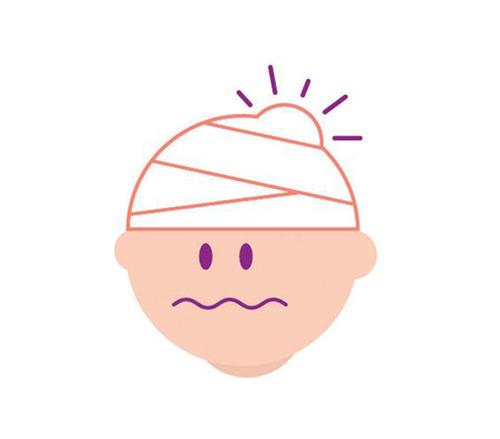You are here
Long-term risks of childhood head injury includes premature death
By Los Angeles Times (TNS) - Aug 24,2016 - Last updated at Aug 24,2016

Photo courtesy of realsimple.com
With freewheeling summer months behind children and school and organised sports just ahead, new research offers some sobering news about the potential for long-term cost when a child’s brain is hurt.
In a study that tracked the life trajectories of more than a million Swedes, young people who sustained a brain injury — including a concussion — before the age of 25 were more likely to have a tougher, and shorter, life than were their uninjured siblings.
Compared to a broad population of their unhurt peers, young people who were treated in the hospital for a single traumatic brain injury before the age of 25 were nearly twice as likely, by their mid-30s or so, to be hospitalised for a psychiatric illness. They were 76 per cent more likely to be unable to work and require disability benefits. And they were 72 per cent more likely to die before reaching the age of 36.
In a bid to ensure that those starkly different outcomes weren’t the product of differing socioeconomic circumstances or family situations, the researchers also compared the outcomes of individuals who sustained a brain injury before age 25 directly with those of a sibling who did not.
That direct comparison only marginally diluted the divergent outcomes of the brain-injured and those who were not. Compared to his or her unharmed sibling, an individual who had at least one brain injury before age 25 was 57 per cent more likely to have an in-patient psychiatric hospitalisation, 49 per cent more likely to receive disability benefits, and 40 per cent more likely to die by his or her mid-30s.
Failing to complete high school and receiving welfare payments were also more common among those with an early brain injury, even after family circumstances were taken into account.
The study, published Tuesday in the journal PLoS Medicine, comes against the backdrop of growing concern about youth brain injuries, particularly those related to organised sports. In 2009, nearly a quarter-million US children (age 19 and under) were diagnosed with and treated in US hospitals for sports- and recreation-related injuries, a 57 per cent rise over an eight-year period.
In a population of 1,143,470 youngsters born between 1973 and 1985, the new study identified 104,290 Swedes who were diagnosed and treated in a hospital for traumatic brain injury before the age of 25. While the severity of those injuries varied, 77.4 per cent were diagnosed as mild TBI — more typically called concussion.
To be sure, the vast majority of the young Swedes in the study — including the 9.1 per cent who were treated in the hospital for a brain injury while young — turned out just fine. In both groups, it was rare to develop serious psychiatric illness or require disability payments by the age of 41, or to die before the age of 36. But among those who had sustained a significant blow to the head, such poor adult outcomes were notably less rare.
Statistically, having such a low rate of poor outcomes can magnify small differences between two groups. When the “base number” of those who die early or experience hardships is tiny, even a numerically small increase in such people can appear as a stark difference.
But it is a difference, and the design of the new research suggests that brain trauma likely contributed to an increased risk of hardship. Moreover, these differences were evident even with the study’s relatively short follow-up period (data collection ended in 2014, when the youngest in the cohort would only have reached 29). The data suggest that as this group of Swedes ages, divergence between the two groups might widen.
Not surprisingly, the worse the youthful brain trauma, the greater was the likelihood of a poorer life course for young Swedes who participated in the study.
But recurrent brain trauma also worsened life prospects. Among those who went to a hospital more than once for a brain injury before the age of 25, the likelihood of ending up on disability in early adulthood was more than 2 1/2 times greater than for the uninjured. One in 11 of those who sustained more than one traumatic brain injury before the age of 25 went on to be considered incapable of work, and thus eligible for disability payments.
In the United States, similar levels of TBI-related disability would exact a tremendous price, the authors reckoned: If TBI affected similar numbers of Americans, keeping them out of the labour force and requiring the payment of disability benefits, the cost over 30 years would be $1.1 trillion, they estimated.
Finally, the authors of the new study found that the age at which a person sustained his or her first brain injury mattered. Those injured later in adolescence and young adulthood fared more poorly than those hurt early, suggesting that a child’s brain may be more resilient in the face of injury than that of a young adult.
In an editorial published alongside the new study, two Canadian injury-prevention specialists, Dr Donald A. Redelmeier and Sheharyar Raza, cautioned that when as many as two or three decades separate an injury from a measured “outcome”, it’s not easy to draw a causal line from one to another.
But, they added, “these data comprise the strongest available long-term analysis of concussions in youths, since a randomised trial is unethical and animal experiments cannot examine psychosocial outcomes”.
All of this bespeaks the importance of preventing brain trauma in young people, said the new study’s authors. When 9 per cent of a cohort is experiencing brain trauma at some point in their youth, they wrote, “basic strategies” — seatbelt and helmet use, better protective gear in athletics, less reckless behaviour — “need more attention”.
Related Articles
Young women who suffer a concussion may be at increased risk of menstrual irregularities, at least for a few months, suggests a new US study
People who have mild traumatic brain injuries may be more likely to have lasting functional deficits that get in the way of daily activities
New research finds that after sustaining a mild traumatic brain injury, nearly 9 in 10 teens who have ongoing concussion symptoms also have academic problems related to headaches, fatigue and difficulty concentrating.


















